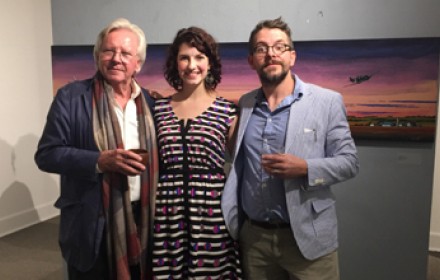The Art of Mentoring

The stereo in Andrew Blanchard’s Union Street studio quietly plays the phantasmagorical soundtrack from the brilliant 2012 film “Beasts of the Southern Wild.” As a backdrop for a long, meandering chat with the hyperkinetic Converse College associate professor of art, the music couldn’t be any more fitting.
The movie’s about a precocious 6-year-old named Hushpuppy, who paints her dire surroundings with lush fantasies. She does what she can to survive, while her father, Wink, says, “My only purpose in life is to teach her how to make it.” Blanchard, a bayou native himself, says much the same thing about his life as an artist and teacher: he shares what he can, shares it the way any Cajun family would share a mess of crawfish. Especially to those who work hardest.
“Andrew and Dunlap are professional artists who’ve been in the game for several years, and the opportunity to show my work aside theirs as a professional artist is a huge deal.”
“I don’t know any different,” Blanchard says. That’s because he came up the same way. As an undergraduate at University of Mississippi, Blanchard hooked his artistic wagon to the Ole Miss star of Bill Dunlap, a renowned painter. In November, Blanchard, Dunlap, and one of Blanchard’s most successful mentees to date, Hailey Hodge, all wound up at the same art gallery at the same time.
“It was one of those complete circles,” Blanchard says of the confluence at Southside Gallery in downtown Oxford, Miss. “I don’t think you get that a lot in life. … Bill’s probably seen it a lot. It’s my first time to experience it, and you’re on a cloud nine.”
Hodge agrees. “It’s definitely surreal,” the 24-year-old Converse graduate says. “It’s a huge honor, to be honest, because Andrew and Dunlap are professional artists who’ve been in the game for several years, and the opportunity to show my work aside theirs as a professional artist is a huge deal.”
The Sumter, S.C., printmaker gives Blanchard major credit for changing her life’s course. He’s a big reason she earned a BFA at Converse in 2014 after already completing a BS in marketing the year before. Now she’s pursuing her MFA at Ole Miss, where Dunlap also happened to see her work.
Her art appeared upstairs from the Dunlap-Blanchard exhibit, Southlandia. The exhibit’s reception brought the three together, along with some other big names, including Stephen King and John Grisham. Ole Miss alum and NFL superstar Eli Manning bought a Blanchard piece.
As for Dunlap, although he is a world-renowned artist he downplays his role—“not sure I even know what it means anymore.” But others applaud how much he does for other artists. William Ferris, former National Endowment of the Humanities chairman, told Garden & Gunmagazine in 2010: “Bill’s generosity in supporting Southern artists of all shapes and forms is beyond measure.”
Dunlap just says he believes in the Converse artists and their work.
“I recognized certain things in Andrew’s approach to content, materials, and work habits. His attitude and vision were consistent with my own, and I flatter myself to make that observation,” he says. When he saw Hodge’s work, “I was most impressed with her skill set, tenacity, and grasp of what was artistically possible.”
All three clearly appreciate the convergence of their work in time and place.
“As alike as we all may seem on paper, the art is entirely different, highly personal, and if I may say so myself, wonderfully made,” the 71-year-old Dunlap says. “Hailey’s installations in the upstairs white space are totally transformative. Andrew’s big-screen prints downstairs are intimate and profound.” He doesn’t say how incredible his own paintings are, but one look at the gallery’s site gives you an idea.
Thanks to Dunlap’s support, Blanchard seems well on his way to similar renown. In November 2015, Blanchard had three simultaneous shows: Blue Spiral Gallery in Asheville, N.C.; DRAWL gallery in Little Rock, Ark., and in Oxford. That explains why his studio has few pieces in it now, he says. But he’s working on more, just as he’s working on making his students make more work, too.
“I want them to do what I do, and that’s to show and get published and get your name out there.”
“I want them to do what I do, and that’s to show and get published and get your name out there. Whatever resources I have, I offer to help them get it done,” he says. “And they do.”
He adds: “My two or three printmaking students every year do more than most big university undergrad and graduate printmakers combined. It’s unbelievable. They’re in the New York art magazines; they’re collected by big museums; they’re in so many juried shows in the United States.”
Like Dunlap, Blanchard seems a bit wary of giving himself too much credit for his students’ successes. “I’ve been blessed every year to have a few students who work hard, and they go through the hoops. I gotta admit, the caliber of work that comes out of those Converse women, I’ll put it up against any of the big-name schools.”
Blanchard understands that artists’ fortunes rise and fall together, like the tides in Louisiana’s bayous– everyone surviving with everyone else’s help. “I feel like if I do for them what has happened for me, art’s just gonna keep happenin’.”